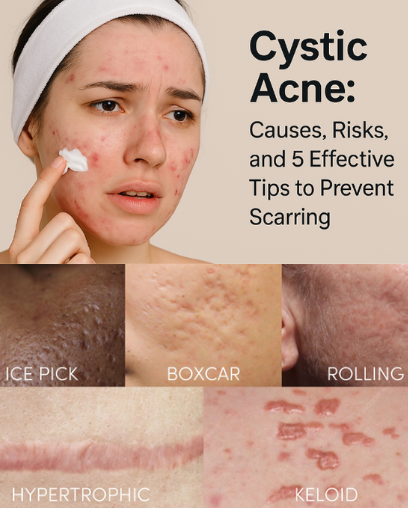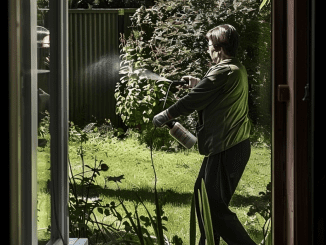
Acne doesn’t discriminate. It can show up whether you’re a teenager or an adult, and while some people only experience mild breakouts, others deal with painful, stubborn cystic acne that leaves long-lasting scars. The real problem? Many of us assume acne will simply heal on its own and forget that different types of acne demand different approaches.
Cystic acne is one of the most severe forms—deep, inflamed, and often scarring. But don’t worry, managing it is possible with the right strategy. Let’s explore what cystic acne really is, why it leads to scarring, and how you can manage it effectively.
Understanding Cystic Acne and Its Risks
Cystic acne forms deep beneath the skin’s surface, where bacteria, sebum, and dead skin cells create painful nodules and pus-filled lesions. Unlike surface-level pimples, cystic acne can rupture tiny blood vessels and damage tissue, leaving behind lasting marks.
These painful breakouts often linger for weeks, and even when they heal, they test your patience with redness, uneven texture, or scars. The risk is clear: without proper care, cystic acne not only affects your skin in the moment but also leaves visible reminders for years.
Why Cystic Acne Often Leads to Scars
When cystic acne heals, your body tries to repair the “wound” by producing collagen. If too little collagen forms, it leaves depressed scars (like pitted marks). If too much is produced, it creates raised scars. Since cystic acne is larger and deeper, the healing process is harder to balance—making scars more likely compared to regular acne.
How Long Does Cystic Acne Last?
The unfortunate truth is that cystic acne rarely goes away on its own. Mild to moderate forms may improve with topical care, but severe cases often require medical treatment. If your breakouts are persistent, painful, or widespread, visiting a dermatologist is the smartest step. Still, there are at-home practices and products that can help reduce flare-ups and prevent scars.
Video : How to Treat & Fade Acne Scars like a Dermatologist! | Dr. Shereene Idriss
5 Proven Tips to Manage Cystic Acne
1. Choose Products with Anti-Inflammatory and Antibacterial Ingredients
- Salicylic Acid: A beta-hydroxy acid that exfoliates, unclogs pores, and reduces redness. Even at just 1% concentration, it’s effective. Overuse, however, can dry out your skin—so moderation is key.
- Oligopeptide-10: Known for fighting Propionibacterium acnes (the bacteria behind most breakouts). It works best when combined with salicylic acid in serums.
- Boswellia Serrata Resin Extract: A natural anti-inflammatory used for centuries. Available in creams and gels, it helps calm swelling, reduce infection, and heal lesions.
Together, these ingredients target acne at the root while soothing irritated skin.
2. Use a Cold Compress to Calm Pain
Cystic acne can be very painful. Applying an ice cube wrapped in a cloth for a few minutes reduces inflammation and numbs discomfort. This simple hack shrinks swollen blood vessels beneath the breakout and provides quick relief.
3. Stop Popping or Squeezing Pimples
We know it’s tempting, but popping cystic acne spreads bacteria deeper into the skin, causes more inflammation, and dramatically increases the risk of scars. The best approach is patience and proper treatment.
4. Wash with a Non-Comedogenic Cleanser
Harsh cleansers or products with pore-clogging ingredients (like Sodium Laureth Sulfate or Steareth-10) make acne worse. Instead, use a mild, non-comedogenic face wash that suits oily or acne-prone skin. Look for formulas with Zinc PCA, which balances oil and strengthens the skin barrier.
Pro Tip: Don’t overwash. Stripping your skin of oils triggers your glands to produce even more sebum, which only worsens acne.
5. Never Skip Moisturizer
If your skin is oily, you may think moisturizers will clog pores—but the opposite is true. When skin is dehydrated, oil glands work overtime, producing excess sebum that leads to more breakouts.
The solution? A lightweight, oil-free, non-comedogenic moisturizer. It hydrates your skin without greasiness, preventing both dryness and new pimples.
Why Prevention Is Better Than Cure
Once cystic acne scars develop, treating them takes months—sometimes even years. Preventing them saves you time, money, and stress. By sticking to an acne-friendly skincare routine and seeking professional help when needed, you protect your skin from long-term damage.
Patience is crucial. Cystic acne won’t vanish overnight, but with consistent care, you can manage flare-ups, reduce pain, and prevent scarring.
Video : Acne Scar Treatments That Work! | Dr. Sam Ellis
Final Thoughts: Stay Consistent, Stay Patient
Cystic acne is tough, but not unbeatable. With the right combination of anti-inflammatory ingredients, gentle cleansing, moisturization, and smart habits like avoiding popping pimples, you can minimize damage and support your skin’s healing process.
The takeaway? Prevention and consistency matter more than quick fixes. Invest in your skin today with the right regimen, and over time, you’ll see fewer breakouts, smoother texture, and a happier complexion.


